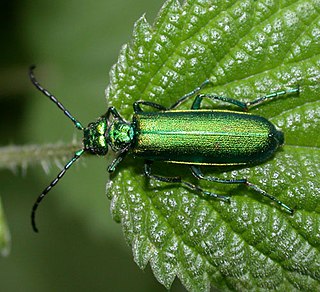
The Spanish fly is an aposematic emerald-green beetle in the blister beetle family (Meloidae). It is distributed across Eurasia.

Meloe proscarabaeus is a European oil beetle. It lives in meadows, field margins and other warm sites in all but the far north of the continent. It lacks hind wings and the elytra are correspondingly reduced in size.

Habropoda laboriosa, the southeastern blueberry bee, is a bee in the family Apidae. It is native to the eastern United States. It is regarded as the most efficient pollinator of southern rabbiteye blueberries, because the flowers require buzz pollination, and H. laboriosa is one of the few bees that exhibit this behavior. It is active for only a few weeks of the year, while the blueberries are in flower during early spring, when the temperature is warm and humid. H. laboriosa are solitary bees that live alone but nest in close proximity with other nests of their species. They have similar features to bumble bees, but they are smaller in size compared to them. H. laboriosa are arthropods so they have segmented bodies that are composed of the head, thorax, and abdomen.

A planidium is a specialized form of insect larva seen in the first-instar of a few families of insects that have parasitoidal ways of life. They are usually flattened, highly sclerotized (hardened), and quite mobile. The function of the planidial stage is to find a host on which the later larval instars may feed, generally until the insect pupates.
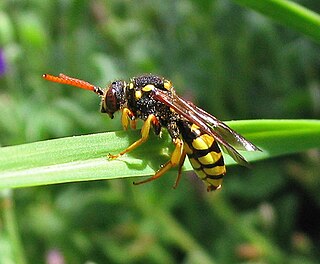
With over 850 species, the genus Nomada is one of the largest genera in the family Apidae, and the largest genus of cuckoo bees. Cuckoo bees are so named because they enter the nests of a host and lay eggs there, stealing resources that the host has already collected. The name "Nomada" is derived from the Greek word nomas, meaning "roaming" or "wandering."

Meloe is a genus of blister beetles commonly referred to as oil beetles. The name derives from their defensive strategy: when threatened by collectors or predators they release oily droplets of hemolymph from their joints. This fluid is bright orange and contains cantharidin, a poisonous chemical compound. Wiping the chemical on skin can cause blistering and painful swelling of the skin. This defensive strategy is not exclusive to this genus; all meloids possess and exude cantharidin upon threat.

Phoresis or phoresy is a non-permanent, commensalistic interaction in which one organism attaches itself to another solely for the purpose of travel. Phoresis has been observed directly in ticks and mites since the 18th century, and indirectly in fossils 320 million years old. It is not restricted to arthropods or animals; plants with seeds that disperse by attaching themselves to animals are also considered to be phoretic.

Meloe violaceus, the violet oil beetle, is a species of oil beetle belonging to the family Meloidae subfamily Meloinae.

Colletes hederae, the ivy bee, is a species of plasterer bee belonging to the family Colletidae subfamily Colletinae.

Lytta nuttalli, or Nuttall's blister beetle, is a species of North American beetle first described in 1824 by Thomas_Say. The genus Lytta is from a Latin word suggesting madness The specific nuttallii recognizes the contributions of Thomas Nuttall, a contemporary of Say.
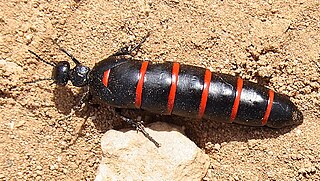
Berberomeloe majalis, the red-striped oil beetle, is an insect in the genus Berberomeloe, in the family of Blister Beetles. It is native to the western Mediterranean Basin.

Ceroctis capensis, or spotted blister beetle, is diurnal and endemic to Southern Africa occurring in diverse habitats, and belonging to the Meloidae or Blister beetle family. It secretes a toxic liquid from its leg joints when roughly handled, blistering human skin. This species somewhat resembles Mylabris oculata, a member of the same family.

Stenoria analis, the ivy bee blister beetle, is a species of blister beetle from the family Meloidae which is found in western Europe and North Africa and is a specialist cleptoparasite of the ivy bee larvae. Its occurrence in regions outside of the known range of the ivy bee, for example in North Africa, suggest that it has other hosts.

Meloe americanus, the buttercup oil beetle, is a species of blister beetle in the family Meloidae. It is found in North America.
Tegrodera aloga, the iron cross blister beetle, is a species of blister beetle in the family Meloidae. It is found in Arizona, California, and Sonora.
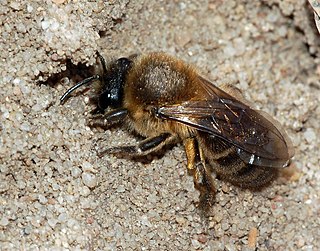
Colletes cunicularius, the vernal colletes or spring mining bee, is a species of solitary bee from the family Colletidae which is widespread in the Palearctic from Britain to the Pacific Ocean which nests in areas of open, sandy soil.
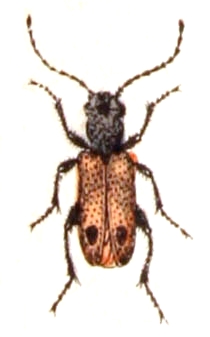
Apalus bimaculatus, the early blister beetle, is a species of blister beetle from the family Meloidae. It is the type species of the genus Apalus.

Sitaris muralis is a species of blister beetle in the subfamily Nemognathinae in the family Meloidae. It is found in Western Europe. It is a black beetle with buff-orange patches on the front of the elytra. It is a kleptoparasite of digger bees.

Meloetyphlus fuscatus, the blind blister beetle, is a species of blister beetle in the family Meloidae found in Central and South America. They are kleptoparasites of orchid bees and are entirely blind as adults. Unique among meloids, females do not lay their eggs near flowers, but rather within their hosts' nests.

Physomeloe corallifer is a species of blister beetle native to the Iberian Peninsula, it is the only recognised species in the genus Physomeloe.



















